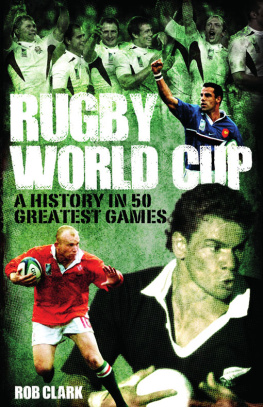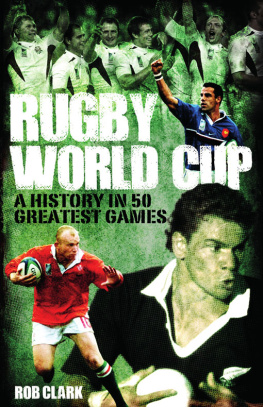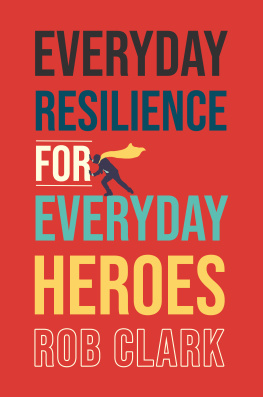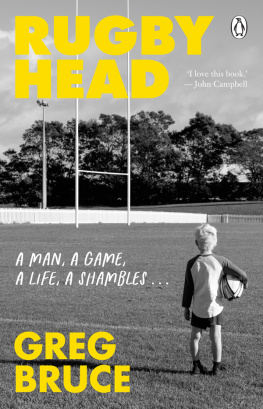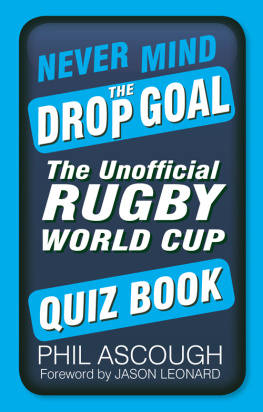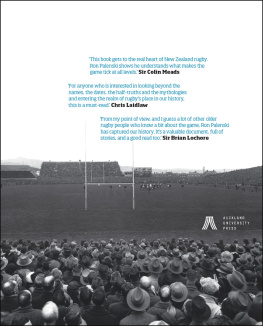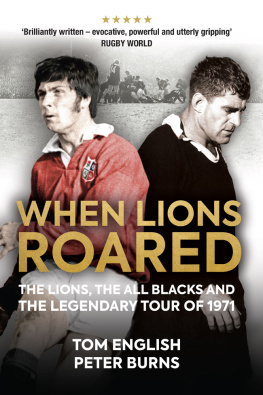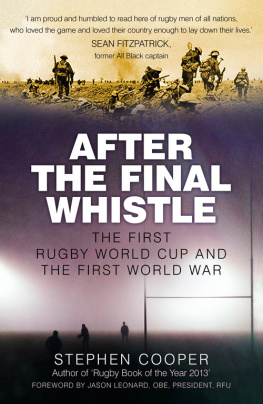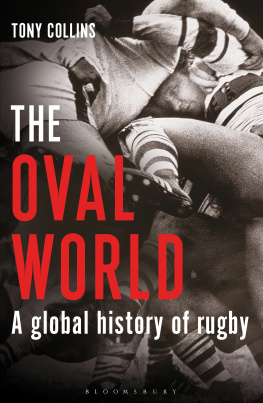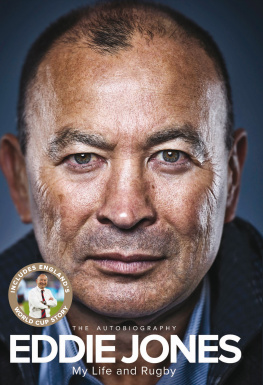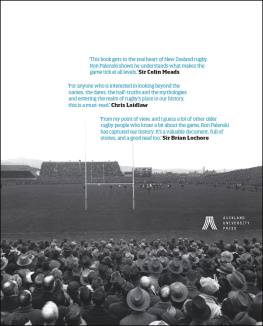DEDICATIONS
To the memory of my dad, whose love of rugby has become my own.
To those who had the foresight and determination to set up a Rugby World Cup and to turn it into the incredible sporting event it is today.
First published by Pitch Publishing, 2015
Pitch Publishing
A2 Yeoman Gate
Yeoman Way
Durrington
BN13 3QZ
www.pitchpublishing.co.uk
Rob Clark, 2015
All rights reserved under International and Pan-American Copyright Conventions. By payment of the required fees, you have been granted the non-exclusive, non-transferable right to access and read the text of this e-book on-screen. No part of this text may be reproduced, transmitted, downloaded, decompiled, reverse-engineered, or stored in or introduced into any information storage and retrieval system, in any form or by any means, whether electronic or mechanical, now known or hereinafter invented, without the express written permission of the Publisher.
A CIP catalogue record is available for this book from the British Library
Print ISBN 978-1-78531-053-9
eBook ISBN: 978-1-78531-106-2
--
Ebook Conversion by www.eBookPartnership.com
CONTENTS
ACKNOWLEDGEMENTS
W hen I started researching the history of the Rugby World Cup, I found there werent nearly as many books on the subject as one would expect. However, those that there are proved to be an excellent and invaluable source and I am indebted to the following: In Pursuit of Bill: A Comprehensive History of the Rugby World Cup by Lance Peatey; Story of the Rugby World Cup by Nick Farr-Jones; World Cup: Rugbys Battle of the Giants by Gerald Davies; Rugby Disunion: The Making of Three World Cups by Derek Wyatt; The Little Book of the Rugby World Cup by Paul Morgan; 101 Moments of World Cup Rugby by Wynne Gray; The History of the Rugby World Cup by Gerald Davies; UnionWorld Cup Winners by Peter Murray; White Gold: Englands Journey to World Cup Glory by Peter Burns; and particularly Thirty Bullies: A History of the Rugby World Cup by Alison Kervin.
A special nod to the ESPN website, which is undoubtedly the best source of statistical information relating to the Rugby World Cup that there is, and the ideal place to double-check information on team line-ups and scorers and other facts and figures.
I am indebted to the BBC and to a whole host of our national newspapers and their journalists, including Mick Cleary, Robert Kitson and John Mason, whose reports I have sometimes quoted from, and to the National Newspaper Library in Colindale.
A personal thanks to Nick Axford, Kevin Peters, James Baker, Martin Peters and everyone else with whom I have been to rugby matches over the years.
Thanks to my wife, Sarah, who has managed to put up with not only my passion for the game, but also the fact that I have passed it on to my children, Matt and Ellie.
And finally I appreciate the support, and patience, of Paul and Jane Camillin at Pitch Publishing. Apologies to anyone I have inadvertently missed out from the above list.
Rob Clark
INTRODUCTION
W hen the Rugby World Cup was first mooted, in the mid-1980s, it was very much a Southern Hemisphere-driven initiative, not least to stave off the growing influence of rugby league which, in Australia at least, was threatening the very existence of the amateur code as it then was. The Five Nations teams were lukewarm about the prospect, and tales which came out of the English, Scottish and Welsh camps in particular indicated that they werent approaching the first competition, in 1987, with perhaps total dedication to the cause.
In the 28 years since the first Rugby World Cup, the tournament has grown spectacularly, beyond the wildest dreams of even its most ardent proponents. According to World Rugby, attendance figures have grown from 604,500 in 1987 to almost 1.5m in 2011, while income from gate receipts, broadcasting rights and sponsorship have also grown exponentially between 1995 (the first World Cup from which there are accurate figures) and 2011. The 2003 final between Australia and England remains the most-watched rugby match in the history of Australian television.
It is now, arguably, the third biggest global sporting event, behind only the summer Olympic Games and the FIFA World Cup and, like them, its four-yearly cycle is well established, giving just the right amount of time for the increasingly popular, and populated, qualifying competition to take place, and for the excitement and anticipation to build. If there is one lesson rugby could learn from football it would be not to seed the tournament too long in advance of it starting the 2015 edition has thrown up the ludicrous situation of host nation England, two-time winners Australia and fifth-ranked Wales (who reached the semi-finals in 2011) all featuring in Pool A, with only two of the three able to qualify for the knockout stages. It seems unfortunate that the tournament will lose a potential winner before even reaching the quarter-final stage.
That apart, the growth of the Rugby World Cup can justifiably be called a phenomenon. From its beginnings in 1987 when the places were filled by the seven International Rugby Board (now in its new guise as World Rugby) members plus nine invited nations, it now boasts a qualifying tournament which in 2015 involved 80 teams as far flung as Guam and Finland, and St Lucia and Vanuatu. The 2015 qualifying competition began less than six months after the 2011 World Cup Final had taken place, and the first match, between Mexico and Jamaica, was refereed by Craig Joubert, one of the worlds top referees and the man who had taken charge of that 2011 final between New Zealand and France.
The Rugby World Cup has had to cope with the advent of professionalism and the reintroduction into the sporting arena of South Africa. It has had to appreciate that a sport which grows ever more physical by the year requires sufficient rest and recovery time between matches, and a sensible amendment to the increasingly rigorous concussion protocols which allows for temporary replacements along the same lines as blood injury replacements will be in force at this years competition. It has had to address the issue that the big rugby-playing nations, the so-called Tier 1 countries, tend to dominate when it comes to the latter stages of the sports most coveted prize, and organisers have tried hard to level some aspects of the playing field, including persuading the Tier 1 nations to play midweek games to allow the smaller nations similar rest periods, which, again, will happen in 2015.
In among the ongoing issues, however, the Rugby World Cup has thrown up the most incredible matches, some of the greatest tries we could ever hope to see, and brought to the attention of the wider sporting public the names of the biggest stars in the game. This years RWC will see games spread throughout England (and occasionally in Wales), and many steps have been taken to spread the gospel.
As for the on-field action, who can ever forget the performances of France? Upsetting the Australians in the first Rugby World Cup with the late drama of that Serge Blanco try? Doing the same to New Zealand in the course of scoring 31 unanswered points on the way to their 1999 semi-final victory, and so nearly repeating that feat four years ago when they could, and probably should, have beaten the All Blacks in their own Auckland backyard. Not to mention the 2007 quarter-final when the whole New Zealand nation was outraged that they could possibly be victims of a forward pass

